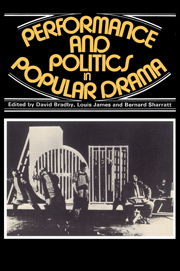 Performance and Politics in Popular Drama
Performance and Politics in Popular Drama Book contents
- Frontmatter
- Contents
- List of contributors
- Preface
- Acknowledgements
- PART ONE Spectacle, performance and audience in nineteenth-century theatre
- Introduction
- Was Jerrold's Black Ey'd Susan more popular than Wordsworth's Lucy?
- Word and image in Pixérécourt's melodramas: the dramaturgy of the strip-cartoon
- Joseph Bouchardy: a melodramatist and his public
- The music of melodrama
- Popular theatre in Victorian Birmingham
- Water drama
- Equestrian drama and the circus
- Theatre of war: the Crimea on the London stage 1854–5
- Popular drama and the mummers' play
- PART TWO Politics and performance in twentieth-century drama and film
- PART THREE Problems and prospects
- Appendix: Tempo, Tempo
- Select bibliography
- General index
- Index of titles of plays, films, sketches
- Index of theatres, theatre companies and groups
Popular drama and the mummers' play
Published online by Cambridge University Press: 08 March 2010
- Frontmatter
- Contents
- List of contributors
- Preface
- Acknowledgements
- PART ONE Spectacle, performance and audience in nineteenth-century theatre
- Introduction
- Was Jerrold's Black Ey'd Susan more popular than Wordsworth's Lucy?
- Word and image in Pixérécourt's melodramas: the dramaturgy of the strip-cartoon
- Joseph Bouchardy: a melodramatist and his public
- The music of melodrama
- Popular theatre in Victorian Birmingham
- Water drama
- Equestrian drama and the circus
- Theatre of war: the Crimea on the London stage 1854–5
- Popular drama and the mummers' play
- PART TWO Politics and performance in twentieth-century drama and film
- PART THREE Problems and prospects
- Appendix: Tempo, Tempo
- Select bibliography
- General index
- Index of titles of plays, films, sketches
- Index of theatres, theatre companies and groups
Summary
For the folklorist, debate over the definition of popular drama has an uneasily familiar ring; for ‘popular culture’ read ‘folk culture’ and many of the principles adduced are identical, as is implied in the oldfashioned terms ‘popular antiquities’, ‘popular traditions’ and ‘popular ballad’, and even more clearly in William Thoms's successful move to replace them all with the term ‘folklore’. In 1846 all that was required was a letter to The Athenaeum; would that matters were still that simple. Not, of course, that the semantic field of the term ‘popular’ has not widened considerably in response to the advent of massculture; the creation and continuous revision of a majority taste by powerful commercial institutions – and not only among manual workers – has widened the gap between art that is popular by destination and art that is popular by origin, so that folklorists at least, being nothing if not sensitive to the inadequacies of their working vocabulary, have on the whole abandoned the concept of popularity as too unspecific to be useful. But it is still striking how much of the terminological debate in popular drama would have fallen gently into place in a folkloristic symposium of the late 1960s or early 1970s.
Seductive as Dreiheit is to the Western academic mind, let me venture this suggestion: that, sub-divisions and quibbles aside, ‘popular’ can mean three things. First, it may advance a quantitative proposition, that such a work of art is to the taste of the majority of a given population as expressed in the crude statistics of box office, record sales, viewer ratings and library borrowings.
- Type
- Chapter
- Information
- Performance and Politics in Popular DramaAspects of Popular Entertainment in Theatre, Film and Television, 1800–1976, pp. 139 - 166Publisher: Cambridge University PressPrint publication year: 1980
- 2
- Cited by


